Step 1- Program Specification
Program specification is the first step in developing a computer program.
- Program specification is also called program definition or
program analysis.
- It requires the programmer to follow five specific tasks:
- Specifying program objectives
- Specifying desired output
- Determining required input
- Defining processing requirements
- Documentation specification
TASK 1 - SPECIFY OBJECTIVES, What are program objectives?
- Program objectives are the problems you are trying to solve.
- A clear statement should be written about the problem that needs a solution.
- This task defines the problem.
TASK 2 - SPECIFY OUTPUT, How do you determine the desired output?
- It is always best to specify outputs before inputs.
- You need to know what you want to get out of the computer.
- Then you can determine what will go into the computer.
- Sketch or write how output will look when it is done.
- Example:

TASK 3 - INPUT DATA - How do you determine the required input?
- The source and type of data must be known.
- The input must supply the program with data to produce the correct output.
- Example:

TASK 4 - PROCESSING REQUIREMENTS - How do you determine processing requirements?
- Processing that must take place to convert input data into output information must correspond
with the problem definition determined in task 1.
- A step-by-step logical algorithm must be determined to process the input data to output
information.
TASKS 5- PROGRAM SPECIFICATIONS DOCUMENT - What is included?
- Document the program objectives, desired outputs, needed inputs, and required processing.
- After these items are documented, then step 2, program design can commence.
< Previous Page
Next Page >


